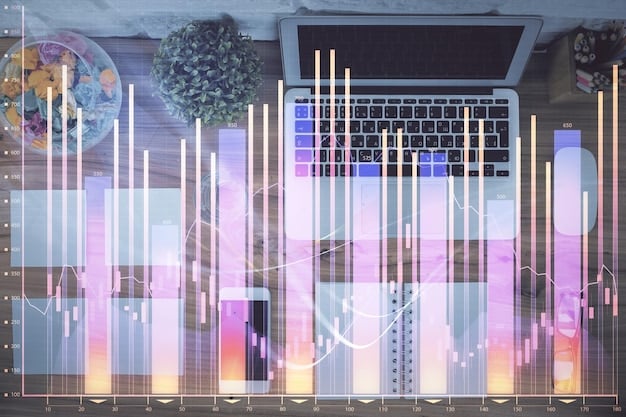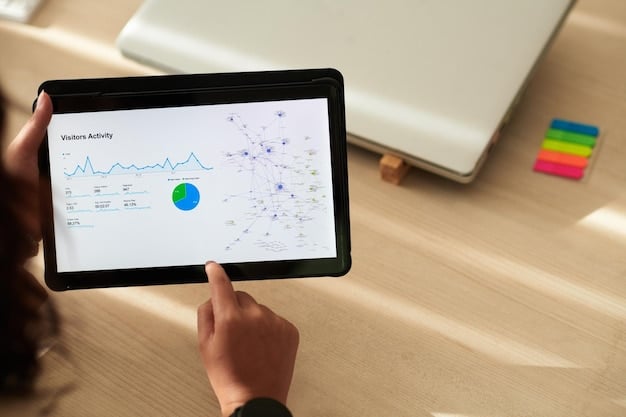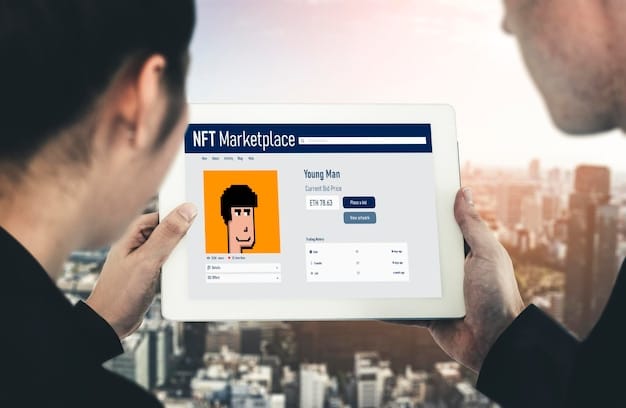Social Media Analytics: Track Key Metrics to Boost Your Bottom Line

Social media analytics is the process of gathering and analyzing data from social media platforms to understand audience behavior, measure the effectiveness of marketing campaigns, and ultimately improve your bottom line by optimizing strategies based on data-driven insights.
In today’s dynamic digital landscape, understanding your social media performance is no longer a luxury—it’s a necessity. Social media analytics provides the insights you need to make informed decisions, optimize your strategies, and ultimately boost your bottom line. Let’s dive into the metrics that truly matter and how to track them effectively.
Understanding Social Media Analytics
Social media analytics involves more than just counting likes and shares. It’s about digging deeper into the data to understand the ‘why’ behind the numbers. By tracking the right metrics, you can gain valuable insights into your audience, content performance, and overall marketing effectiveness.
Why Social Media Analytics Matters
Social media analytics are really important because it means you can see what’s working and what’s not. This helps you fine-tune your approach to making sure you’re getting the best results.
Key Components of Social Media Analytics
The thing about social media analytics is it’s not just about looking at the surface stuff. You need to understand the main pieces of the puzzle to really see the big picture.
- Data Collection: Gathering information from various social media platforms using built-in analytics tools or third-party services.
- Data Analysis: Interpreting the collected data to identify patterns, trends, and actionable insights.
- Reporting: Presenting the analyzed data in a clear and concise format, often using dashboards and reports.
- Actionable Insights: Using the insights gained from the analysis to optimize social media strategies and improve performance.
In conclusion, social media analytics gives you the insights to really get what your audience likes, refine your content, and improve your overall social media approach. This helps you to connect better with people and get real results.

Identifying Key Performance Indicators (KPIs)
KPIs are the specific metrics that indicate how well your social media efforts are achieving your business goals. Identifying the right KPIs is crucial for measuring success and making informed decisions.
Engagement Rate
Engagement rate is a key metric that measures how actively your audience interacts with your content. It’s typically calculated as the number of interactions (likes, comments, shares) divided by the number of impressions or reach.
Reach and Impressions
Reach refers to the number of unique users who have seen your content, while impressions represent the total number of times your content has been displayed, regardless of whether it was clicked on or not.
- Reach: Measures the potential audience size. A high reach indicates that your content is being seen by a large number of users.
- Impressions: Reflects the total visibility of your content. Multiple impressions can come from the same user seeing the content more than once.
- Optimizing for Reach: Focus on creating shareable content and using relevant hashtags to expand your audience.
- Optimizing for Impressions: Increase posting frequency and experiment with different posting times to maximize visibility.
To sum up, focus on finding and tracking the KPIs that really show how your social media work is helping your business goals. Knowing these numbers can help you tweak your plans and prove that your social media efforts are paying off, which is great for making smart choices and improving your overall approach.
Leveraging Platform-Specific Analytics
Each social media platform offers its own analytics tools, providing valuable insights into how your content performs on that specific platform. Understanding these platform-specific metrics can help you tailor your strategy to each platform’s unique audience and algorithm.
Facebook Insights
Facebook Insights provides a wealth of data about your page’s performance, including reach, engagement, and audience demographics. With all the information provided by Facebook, you can better understand your customer base.
Twitter Analytics
Twitter Analytics offers insights into your tweets’ performance, including impressions, engagement rate, and follower growth. There’s lots of great info on Twitter that you can take advantage of.

- Tweet Impressions: The number of times your tweets were seen by users.
- Engagement Rate: The number of engagements (likes, retweets, replies) divided by the number of impressions.
- Follower Growth: The rate at which your account is gaining new followers.
- Top Tweets: Identify your best-performing tweets to understand what resonates with your audience.
To summarise, by using the specific analytics tools of each social platform, you can really focus your efforts on what works best for each one. This means you can make smarter choices and boost your results on different social media sites, leading to better brand growth and engagement.
Analyzing Audience Demographics and Behavior
Understanding your audience is key to creating content that resonates with them and drives engagement. Social media analytics can provide valuable insights into your audience’s demographics, interests, and behavior patterns.
Demographic Data
Demographic data includes information such as age, gender, location, and education level. This also helps with things like income.
Interest and Behavior Data
Interest and behavior data reveals what topics your audience is interested in and how they interact with your content. The data also allows you to see what they search for.
- Content Preferences: Identify the types of content that resonate most with your audience (e.g., videos, images, articles).
- Engagement Patterns: Understand when your audience is most active and engaged on social media.
- Purchase Behavior: Track how social media interactions influence purchasing decisions.
- Custom Audiences: Create targeted advertising campaigns based on audience demographics, interests, and behaviors.
In conclusion, by diving into the analytics to understand who your audience really is – their age, gender, interests, and habits – you can make your content much more appealing to them. This means your posts will grab their attention better, leading to stronger connections and better results, which is really important for growing your online presence.
Using Third-Party Analytics Tools
While social media platforms offer built-in analytics, third-party tools can provide more advanced features and a unified view of your social media performance across multiple platforms. These tools often offer features like automated reporting, competitor analysis, and sentiment analysis.
Benefits of Third-Party Tools
There are lots of advantages of using third-party analytics tools.
Popular Third-Party Tools
There are many, many different kinds of third-party tools to use to help you sort out your social media analytics.
- Hootsuite Analytics: Offers comprehensive analytics, reporting, and social listening features.
- Sprout Social: Provides social media management, scheduling, and analytics tools.
- Buffer Analyze: Focuses on providing simple and actionable analytics for social media.
- Brandwatch: Specializes in social listening and sentiment analysis.
In summary, third-party analytics tools can help you pull together all your data in one place so you can get a more detailed view of your social media performance. They also give you the tools you need to dig deeper into the numbers so you can really understand what’s going on and make smarter choices.
Turning Data into Actionable Insights
The ultimate goal of social media analytics is to turn data into actionable insights that drive business results. This involves identifying key trends, understanding the ‘why’ behind the numbers, and making informed decisions based on the data.
Identifying Key Trends
To make sure your social media efforts are paying off, you’ve got to keep an eye on the trends that pop up in your data.
Making Data-Driven Decisions
Using the findings and turning them into actionable tips means you are making smart choices about where to focus your time and dollars.
- Content Optimization: Refine your content strategy based on what resonates most with your audience.
- Campaign Optimization: Adjust your social media campaigns based on real-time performance data.
- Resource Allocation: Allocate your marketing budget and resources to the most effective channels and tactics.
- Strategic Planning: Develop long-term social media strategies based on data-driven insights.
In short, changing data into actual guidance is really about watching patterns, understanding why things are happening, and making smart choices using what the numbers tell you. This way, you’re not just guessing, but making sure your plans are based on solid info, which helps you get better results.
| Key Point | Brief Description |
|---|---|
| 📊 KPI Tracking | Identify and monitor key performance indicators to measure social media success. |
| 🎯 Audience Analysis | Understand your audience demographics, behaviors, and preferences. |
| 🛠️ Tool Utilization | Leverage platform-specific and third-party analytics tools. |
| 📈 Data-Driven Decisions | Transform analytics into actionable insights for better strategies. |
FAQ
Social media analytics is the process of collecting and analyzing data from social media platforms to understand audience behavior, measure campaign performance, and optimize strategies.
Tracking social media metrics helps you understand what’s working and what’s not, enabling you to refine your approach and improve your results. It ensures your efforts are aligned with your goals.
Key KPIs include engagement rate, reach, impressions, website traffic, and conversion rates. These metrics provide insights into audience interaction and the effectiveness of your content.
To boost engagement, create high-quality, relevant content, engage with your audience, post consistently, and use appropriate hashtags. Understanding your audience’s interests is key.
You can use platform-specific analytics tools like Facebook Insights and Twitter Analytics, as well as third-party tools like Hootsuite Analytics, Sprout Social, and Buffer Analyze for comprehensive analysis.
Conclusion
By harnessing the power of social media analytics , you can transform your social media presence from a guessing game into a strategic, data-driven powerhouse. Focus on tracking the metrics that matter most to your business goals, and use those insights to constantly refine and optimize your strategies for maximum impact.





